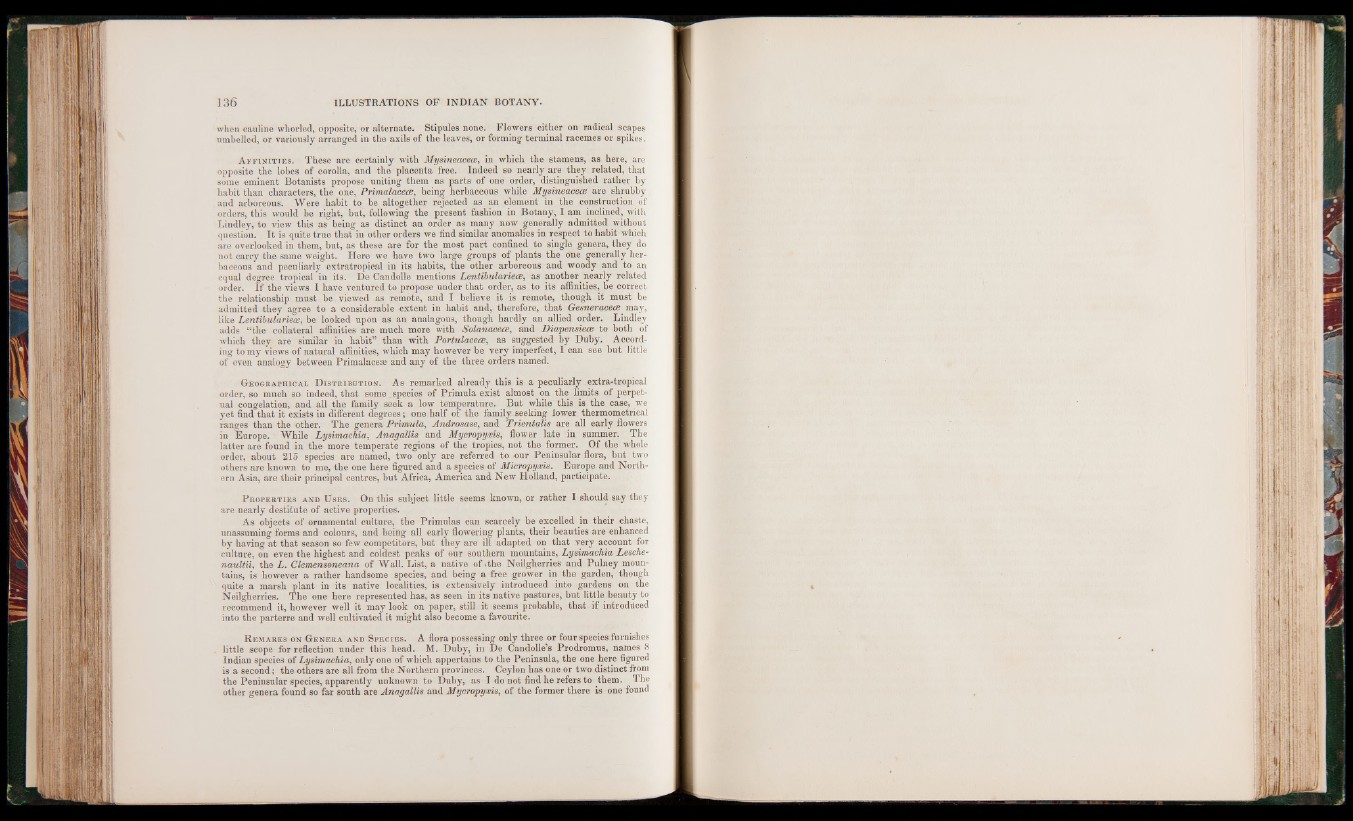
when cauline whorled, opposite, or alternate. Stipules none. Flowers either on radical scapes
umbelled, or variously arranged in the axils of the leaves, or forming terminal racemes or spikes.
Af f in it ie s . These are certainly with Mysineacece, in which the stamens, as here, are
opposite the lobes of corolla, and the placenta free. Indeed so nearly are they related, that
some eminent Botanists propose uniting them as parts of one order, distinguished rather by
habit than characters, the one, Primalacece, being herbaceous while Mysineacece are shrubby
and arboreous. Were habit to be altogether rejected as an element in the construction of
orders, this would be right, but, following the present fashion in Botany, I am inclined, with
Lindley, to view this as being as distinct an order as many now generally admitted without
question. I t is quite true that in other orders we find similar anomalies in respect to habit which
are overlooked in them, but, as these are for the most part confined to single genera, they do
not carry the same weight. Here we have two large groups of plants the one generally herbaceous
and peculiarly extratropical in its habits, the other arboreous and woody and to an
equal degree tropical in its. De Candolle mentions Lentibulariece, as another nearly related
order. If the views I have ventured to propose under that order, as to its affinities, be correct
the relationship must be viewed as remote, and I believe it is remote, though it must be
admitted they agree to a considerable extent in habit and, therefore, that Gesneracece may,
like Lentibulariece, be looked upon as an analagous, though hardly an allied order. Lindley
adds “the collateral affinities are much more with Solanacece, and Diapensiece to both of
which they are similar in habit” than with Portulacece, as suggested by Duby. According
to my views of natural affinities, which may however be very imperfect, I can see but little
of even analogy between Primalacese and any of the three orders named.
Geographical Distribution. As remarked already this is a peculiarly extra-tropical
order, so much so indeed, that some species of Primula exist almost on the limits of perpetual
congelation, and all the family seek a low temperature. But while this is the case, we
yet find that it exists in different degrees; one half of the family seeking lower thermometrical
ranges than the other. The generaPrimula, Androsase, and Trientalis are all early flowers
in Europe. While Lysimackia, Anagallis and Mycropyoois, flower late in summer. The
latter are found in the more temperate regions of the tropics, not the former. Of the whole
order, about 215 species are named, two only are referred to our Peninsular flora, but two
others are known to me, the one here figured and a species of Micropyoois. Europe and Northern
Asia, are their principal centres, but Africa, America and New Holland, participate.
P roperties and U ses. On this subject little seems known, or rather I should say they
are nearly destitute of active properties.
As objects of ornamental culture, the Primulas can scarcely be excelled in their chaste,
unassuming forms and colours, and being all early flowering plants, their beauties are enhanced
by having at that season so few competitors, but they are ill adapted on that very account for
culture, on even the highest and coldest peaks of our southern mountains, Lysimackia Lesche-
naultii, the L. Clemensoneana of Wall. List, a native of,the Neilgherries and Pulney mountains,
is however a rather handsome species, and being a free grower in the garden, though
quite a marsh plant in its native localities, is extensively introduced into gardens on the
Neilgherries. The one here represented has, as seen in its native pastures, but little beauty to
recommend it, however well it may look on paper, still it seems probable, that if introduced
into the parterre and well cultivated it might also become a favourite.
R emarks on Genera and Species. A flora possessing only three or four species furnishes
. little scope for reflection under this head. M. Duby, in De Candolle’s Prodromus, names 8
Indian species of Lysimackia, only one of which appertains to the Peninsula, the one here figured
is a second; the others are all from the Northern provinces. Ceylon has one or two distinct from
the Peninsular species, apparently unknown to Duby, as I do not find he refers to them. The
other genera found so far south are Anagallis and Mycropyoois, of the former there is one found